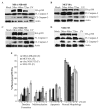The Tumor Suppressor, p190RhoGAP, Differentially Initiates Apoptosis and Confers Docetaxel Sensitivity to Breast Cancer Cells
- PMID: 21779478
- PMCID: PMC3111004
- DOI: 10.1177/1947601911402680
The Tumor Suppressor, p190RhoGAP, Differentially Initiates Apoptosis and Confers Docetaxel Sensitivity to Breast Cancer Cells
Abstract
p190RhoGAP (p190) is a negative regulator of RhoGTPases and a putative tumor suppressor, whose mechanism of tumor suppression is poorly defined. Ectopic expression of p190 induces various morphological phenotypes, including multinucleation, dendrite-like formation, and chromatin condensation, suggesting an involvement in apoptosis. We examined the possibility that p190 can function as a tumor suppressor by regulating induction of apoptosis. We show that the predominant phenotype of p190 overexpression in a variety of cell lines is apoptosis, which is mediated through p190's regulation of Rho and caspases. The secondary phenotypes, multinucleation and dendrite-like formation, are determined by transformation status, not cell lineage, and appear to be intermediate phenotypes in the p190-induced apoptotic pathway. Finally, we show that p190 levels can regulate the apoptotic response of breast cancer cell lines to docetaxel through its regulation of Rho. Together, these findings suggest that one mechanism by which p190 can mediate its tumor-suppressive function is through regulation of Rho-activated cell death pathways and that this function can be exploited to optimize the action of cytoskeletal-based chemotherapeutics, such as the taxanes.
Keywords: apoptosis; dendrite; docetaxel; multinucleation; p190RhoGAP.
Conflict of interest statement
The author(s) declared no potential conflicts of interest with respect to the authorship and/or publication of this article.
Figures






Similar articles
-
Breast tumor kinase phosphorylates p190RhoGAP to regulate rho and ras and promote breast carcinoma growth, migration, and invasion.Cancer Res. 2008 Oct 1;68(19):7779-87. doi: 10.1158/0008-5472.CAN-08-0997. Cancer Res. 2008. PMID: 18829532
-
p190RhoGAP is cell cycle regulated and affects cytokinesis.J Cell Biol. 2003 Nov 10;163(3):571-82. doi: 10.1083/jcb.200308007. J Cell Biol. 2003. PMID: 14610059 Free PMC article.
-
Mitotic down-regulation of p190RhoGAP is required for the successful completion of cytokinesis.J Biol Chem. 2010 Aug 27;285(35):26923-26932. doi: 10.1074/jbc.M110.103804. Epub 2010 Jun 9. J Biol Chem. 2010. PMID: 20534586 Free PMC article.
-
Signal transduction pathways of taxanes-induced apoptosis.Curr Med Chem Anticancer Agents. 2003 Jul;3(4):291-306. doi: 10.2174/1568011033482422. Curr Med Chem Anticancer Agents. 2003. PMID: 12769774 Review.
-
Regulation of Rho GTPase activity at the leading edge of migrating cells by p190RhoGAP.Small GTPases. 2019 Mar;10(2):99-110. doi: 10.1080/21541248.2017.1280584. Epub 2017 Mar 13. Small GTPases. 2019. PMID: 28287334 Free PMC article. Review.
Cited by
-
Rho GTPase-activating protein 35 rs1052667 polymorphism and osteosarcoma risk and prognosis.Biomed Res Int. 2014;2014:396947. doi: 10.1155/2014/396947. Epub 2014 Jul 20. Biomed Res Int. 2014. PMID: 25136583 Free PMC article. Clinical Trial.
-
Glucocorticoid receptor DNA binding factor 1 expression and osteosarcoma prognosis.Tumour Biol. 2014 Dec;35(12):12449-58. doi: 10.1007/s13277-014-2563-z. Epub 2014 Sep 4. Tumour Biol. 2014. PMID: 25185653
-
Bcl-2 inhibition sensitizes triple-negative human breast cancer cells to doxorubicin.Oncotarget. 2018 May 22;9(39):25545-25556. doi: 10.18632/oncotarget.25370. eCollection 2018 May 22. Oncotarget. 2018. PMID: 29876007 Free PMC article.
-
RhoA is down-regulated at cell-cell contacts via p190RhoGAP-B in response to tensional homeostasis.Mol Biol Cell. 2013 Jun;24(11):1688-99, S1-3. doi: 10.1091/mbc.E12-05-0386. Epub 2013 Apr 3. Mol Biol Cell. 2013. PMID: 23552690 Free PMC article.
-
Genomic Comparison of Endometrioid Endometrial Carcinoma and Its Precancerous Lesions in Chinese Patients by High-Depth Next Generation Sequencing.Front Oncol. 2019 Mar 4;9:123. doi: 10.3389/fonc.2019.00123. eCollection 2019. Front Oncol. 2019. PMID: 30886832 Free PMC article.
References
-
- Hall A. The cytoskeleton and cancer. Cancer Metastasis Rev. 2009;28(1-2):5-14 - PubMed
-
- Heasman SJ, Ridley AJ. Mammalian Rho GTPases: new insights into their functions from in vivo studies. Nat Rev Mol Cell Biol. 2008;9(9):690-701 - PubMed
-
- Aznar S, Fernandez-Valeron P, Espina C, Lacal JC. Rho GTPases: potential candidates for anticancer therapy. Cancer Lett. 2004;206(2):181-91 - PubMed
Grants and funding
LinkOut - more resources
Full Text Sources
